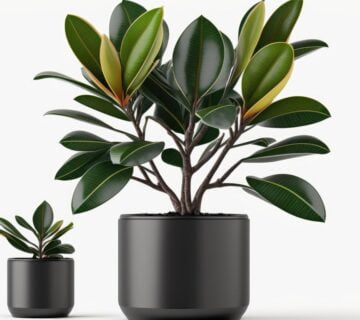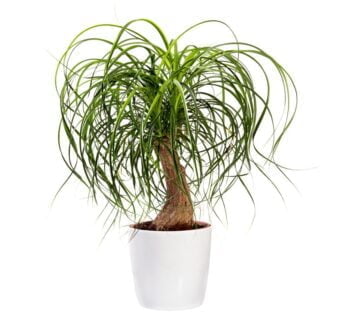Turtle Vine
Turtle Vine, scientifically known as Callisia repens, is a fascinating and versatile plant that offers a range of attractive features.
Trailing Growth:
Turtle Vine is a trailing plant that produces long, slender stems that gracefully cascade down from containers or hang from shelves. Its trailing growth habit makes it a great choice for hanging baskets or as a ground cover in garden beds.
Small, Oval Leaves:
The leaves of Turtle Vine are small, oval-shaped, and succulent in nature. They have a glossy appearance and are usually green, although some varieties may exhibit variegation with stripes or spots of different colors.
Rapid Growth:
This plant is known for its vigorous growth rate. It quickly fills in empty spaces with its lush foliage, creating a dense and verdant display.
Easy Care:
Turtle Vine is a relatively low-maintenance plant, making it suitable for both beginner and experienced gardeners. It can adapt to a variety of growing conditions and is generally forgiving of occasional neglect.
Indoor and Outdoor Plant:
Turtle Vine can be grown both indoors and outdoors, depending on the climate. It thrives in bright, indirect light and can tolerate partial shade. Outdoors, it is well-suited for tropical or subtropical regions.
Versatile Use:
Turtle Vine can be used in various ways to enhance your garden or indoor space. It works well in hanging baskets, mixed container gardens, or as a trailing accent in larger potted plants. It can also be utilized as ground cover or as a filler in garden borders.
Propagation:
This plant is easily propagated through stem cuttings. Simply take a healthy stem, remove a few leaves from the lower portion, and place it in well-draining soil or water until it roots. It quickly establishes new plants, allowing for easy propagation and expansion of your Turtle Vine collection.
Drought Tolerant:
Turtle Vine has good drought tolerance once established. It can withstand short periods of dryness and is capable of storing water in its succulent leaves.
Edible Leaves:
The leaves of Turtle Vine are edible and have a mild flavor. They can be added to salads or used as a garnish, adding a unique touch to culinary creations.
Air Purifying Qualities:
Like many indoor plants, Turtle Vine has air-purifying properties. It helps to improve indoor air quality by filtering out toxins and releasing oxygen, creating a healthier and more pleasant environment.
Overall, Turtle Vine, or Callisia repens, is an attractive and versatile plant that can enhance both indoor and outdoor spaces. Its trailing growth, easy care requirements, and edible leaves make it a popular choice among plant enthusiasts. Whether used as a decorative accent or for its air-purifying benefits, Turtle Vine adds a touch of beauty and vitality to any setting.
Things to know about TURTLE VINE
Common (vernacular) Name
टर्टल वाइन (Hindi), Turtle Vine, Callisia repens, Inch Plant, Creeping Inchplant, Bolivian Jew and many more.
Botanical Name
Callisia repens
Origin
Central and South America
Family
Commelinaceae
Plant Type
Tropical plant
Plant Features
Ornamental / Evergreen / Exotic
Life Cycle
Perennial
Landscape Uses
Container Planting and Houseplants.
Species
Belolonchium, Calomystrium, Cardiolonchium, Chamaerepium, Cordatopunctatum, Dactylophyllium, Decurrentia, Digitinervium, Gymnopodium, Leptanthurium, Pachyneurium, Polyphyllium, Polyneurium, Porphyrochitonium, Schizoplacium, Semaeophyllium, Tetraspermium, Urospadix, Xialophyllium.
Varieties
It comes with thousand of different varieties in a diversity of leaf and flower colorations. Some popular verities are available in a myriad of colors and exotic variegation, such as Temptation, Tropical Red, Red Dragon, Verdun Red, Flame, Mauritius Red, Mauritius Orange, Peach, Casino, Sunshine Orange, Nitta, Acropolis, Linda de Mol, Mauritius White, Lima, Manoa Mist, Abe Pink, Candy Stripe, Passion, Midori, Esmaralda, Titicaca, Jewel, Akapana, Cardinal, Fantasia (cream with pink veins), Chocos, Chicos (chocolate brownish red), and many more.
Size
Height : 1 to 1.5 feet tall and Width : 1 feet wide when mature.
Indoors or Outdoors
Outdoors : Anthurium can be used outdoors in shady plantings, avoid direct sun light.
Indoors : Excellent plant grow in bright light or indirect light. Best indoor plants for beginners.
Blooming / Flowering
Blooming period is throughout the year.
Flower Colour
It’s come with a contrasting spadix Gold, Yellow, Orange, Pink, White, Green, Purple, Red, Burgundy, Multicolored and Variegated colours.
Lucky Plant
According to Feng Shui, It bring Good Luck in your relationships.
Lighting / Sun Exposure
Bright Indirect Sunlight.
Temperature
Grow best preferably warm temperature above 21°C and can be tolerate max temp. as high as 32°C.
Growth Rate
Anthurium is a slow to moderate growers plant.
Watering
Moderate watering, Mist or over head sprinkler to provide water and to improve relative humidity. Not tolerate overwatering it may cause root damage and yellowing of the leaves.
Fertilizer
Slow-release fertilizer, or a water-soluble liquid fertilizer once or twice in the growing season (Spring through Summer).
i.e. - Cow dung, DAP, Compost, NPK 30-10-10 fertilizer, liquid organic fertilizer etc.
Pruning
Pruning of Anthurium not much is needed. However, trimming away only discolored or dead leaves.
Propagation
Seeds : The best time to sow your Anthurium seeds is in the end of Winter / early Spring but it can't can give good result.
Stem Cuttings : The easier methods of propagation of Anthurium in water or in soil via stem cuttings, and can be done during the warm growing season.
Division : Division of Anthurium can be done in Rainy season, or better in February to March.
Dormancy Period
Month : November to February (winter season)
Shed their leaves and show poor growth, Watering minimally.
Avoid : Propagate, Fertilize and Repotting.
Container
Ceramic Pot, Plastic Pot, Terracotta or Clay Pot is preferred, which ensures good drainage as well as water holding capacity.
Soil Type
A well-drained Loam / Coarse potting soil is recommended as well as water holding capacity. Prevent soggy potting medium.
Our recommendation for potting mix : Equal part mixture of Garden Soil (25%) + Compost (25%) + River Sand (25%) + Cocopeat (25%). You can substitute pieces of Charcoal, Vermicompost, Perlite etc.
Soil pH
Lightly Acidic soil - Ideally 5.5 to 6.5 pH (potential of hydrogen) is recommended for Anthurium.
Repotting
It is advisable to repot the Anthurium every year or two preferably spring to midsummer season.
Maintenance
Low maintenance and easy to grow.
Properties
Toxic or Poisonous to both humans and pets upon ingestion.
Benefits
Excellent indoor air purifier, Anthurium plants turns CO2 into oxygen. It purifies indoor air by removing harmful chemicals like ammonia, toluene, xylene and formaldehyde.
Special Features
Doesn't attract hummingbirds and pollinators like butterflies and bees or wasps.
Infestation / Pests
Aphids, Scale insects, Thrips, Mealy bugs, Spider mites and caterpillars etc.
Diseases / Problem
Physiological Problem : Anthracnose, Leaf Spot and Powdery Mildew.
Bacterial Problem : Bacterial Blight, Bacterial Wilt and Black Nose Disease.
Fungal Problems : Root Rot and Water Mold.
Some Glimpse of TURTLE VINE











No comment